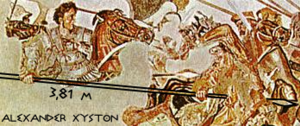ξυστόν
Τὰ μηδὲν ὠφελοῦντα μὴ πόνει μάτην → Ne tu labores frustra in iis, quae nil iuvant → Müh nicht umsonst mit dem, was dir nichts nützt, dich ab
English (LSJ)
τό, (ξύω, lit.
A shaved, sc. δόρυ) xyston, shaft, pole, e.g. spear-shaft, ξ. χαλκῆρες Il.11.260; μακροῖσι ξ. 13.497, cf. 15.677; opp. λόγχαι (the head), Hdt.1.52, cf. Plu.Rom.20.
2 spear, E.Hec.920 (lyr.); a horseman's lance, X.Cyr.4.5.58, cf. 7.1.33, Plu.Aem.16: pl. ξυστοί Jul.Or.2.60a codd.
3 v. ξυστός.

German (Pape)
[Seite 283] τό (ξύω), 1) die geglättete hölzerne Stange des Wurfspießes, der Lanzenschaft, die Lanze selbst; οὔτησε ξυστῷ χαλκήρεϊ, Il. 4, 469. 11, 260, vgl. 15, 677, wo er 22 Ellen lang ist; νύσσοντες ξυστοῖσι μέσον σάκος, 11, 565; Eur. Hec. 920; τὸ ξυστὸν τῇσι λόγχῃσι ἐὸν ὁμοίως χρύσεον, Her. 1, 52; bei Xen. Cyr. 7, 1, 33 zwischen δόρατα und μάχαιραι genannt; VLL. erkl. ἀκόντιον, δορύλλιον. – 2) ein Werkzeug der Zimmerleute, wahrscheinlich zum Richten und Abgleichen zweier Oberflächen, Galen.; auch der Maurer, Schol. Ar. Av. 1149. – 3) bei E. M. auch = ξυστίς, χιτὼν γυναικεῖος, τραγικὸν ὑπένδυμα. – 4) = Folgdm, xystum der Römer.
French (Bailly abrégé)
οῦ (τό) :
bois d'une javeline ; javelot.
Étymologie: ξυστός¹.
Russian (Dvoretsky)
ξυστόν: τό
1 древко копья Hom. etc.;
2 копье: οὔτησε ξυστῷ χαλκήρεϊ Hom. (Элефенора Агенор) поразил медным копьем.
Greek (Liddell-Scott)
ξυστόν: τό, (ξύω) τὸ ἐξεσμένον ξύλον ἢ στέλεχος τοῦ δόρατος, Ἰλ. Λ. 260· μακροῖσι ξυστοῖσι Ν. 497· ἔχον μῆκος εἴκοσι καὶ δύο πήχεων, νώμα δὲ ξυστὸν μέγα ναύμαχον ἐν παλάμῃσιν, κολλητὸν βλήτροισι, δυωκαιεικοσίπηχυ Ο. 677· ἐν ἀντιθέσει πρὸς τὸ λόγχη, Ἡρόδ. 1. 52. 2) καθόλου, ὡς τὸ δόρυ, χαλκῆρες Ἰλ. Δ. 469, πρβλ. Εὐρ. Ἑκάβ. 920· δόρυ ἱππέως (ἴδε ξυστοφόρος), Ξεν. Κύρ. 4. 5, 58, πρβλ. 7. 1, 33.
English (Autenrieth)
(ξύω): the polished shaft of a spear, spear; ναύμαχον, ‘ship-pike,’ Il. 15.388, 677.
Greek Monotonic
ξυστόν: τό (ξύω)·
1. στιλβωμένη λαβή, κοντάρι, δόρατος, σε Ομήρ. Ιλ., Ηρόδ.
2. γενικά, ακόντιο, δόρυ, λόγχη, σε Ομήρ. Ιλ., Ευρ.
Frisk Etymological English
1
Grammatical information: n.
Meaning: spearshaft, usually spear (Il., Hdt., E., X.).
Origin: GR [a formation built with Greek elements]
Etymology: As "the smoothed, smoother stick" (δόρυ) to ξύω, s. v.
Middle Liddell
ξυστόν, οῦ, [ξύω]
1. the polished shaft of a spear, Il., Hdt.
2. generally, a spear, lance, Il., Eur.
Frisk Etymology German
ξυστόν: 1.
{ksustón}
Grammar: n.
Meaning: Speerschaft, gew. Speer, Lanze (Il., Hdt., E., X. usw.).
Etymology: Als "das Geglättete, geglättete Stange" (δόρυ) zu ξύω, s. d.
Page 2,341
Wikipedia EL
Το ξυστόν ήταν αρχαίο ελληνικό όπλο. Ήταν σουβλί μήκους δύο έως τριών μέτρων, που το χρησιμοποιούσαν οι οπλίτες. Ο μαχητής το κρατούσε και το χειριζόταν με ένα χέρι, ενώ με το άλλο κρατούσε την ασπίδα. Σε αντίθεση με το δόρυ ή την σάρισα, δεν το εξακόντιζαν.
Wikipedia EN
The xyston (Ancient Greek: ξυστόν "spear, javelin; pointed or spiked stick, goad (lit. 'shaved')"), a derivative of the verb ξύω "scrape, shave", was a type of a long thrusting spear in ancient Greece. It measured about 3.5–4.25 meters (11.5–13.9 ft) long and was probably held by the cavalryman with both hands, although the depiction of Alexander the Great's xyston on the Alexander Mosaic in Pompeii (see figure), suggests that it could also be used single handed. It had a wooden shaft and a spear-point at both ends. Possible reasons for the secondary spear-tip were that it acted partly as a counterweight and also served as a backup in case the xyston was broken in action. The xyston is usually mentioned in context with the hetairoi (ἑταῖροι), the cavalry forces of ancient Macedon. After Alexander the Great's death, the hetairoi were named xystophoroi (ξυστοφόροι, "spear-bearers") because of their use of the xyston lance. In his Greek-written Bellum Judaicum, the Jewish historian Flavius Josephus uses the term xyston to describe the Roman throwing javelin, the pilum.
The xyston was wielded either underarm or overarm, presumably as a matter of personal preference. It was also known, especially later, as the kontos; meaning literally "barge-pole"; the name possibly originated as a slang term for the weapon.
Wikipedia DE
Der Xyston war eine Lanze, die sowohl von Reitern als auch von Fußsoldaten für den Nahkampf benutzt wurde. Anders als die später in Gebrauch kommende schwere Sarissa war er nur drei Meter lang und hatte eine etwa 30 cm lange Spießklinge. Der Xyston wurde von griechischen Hopliten neben dem Schild Hoplon und dem Schwert Kopis getragen. Der Xyston war auch ein Bestandteil der Bewaffnung von leichtbewaffneten griechischen Fußtruppen, wie den Evzonoi oder den Psiloi. Auch von der Kavallerie wurde der Xyston im größeren Umfang benutzt (siehe Abbildung).
